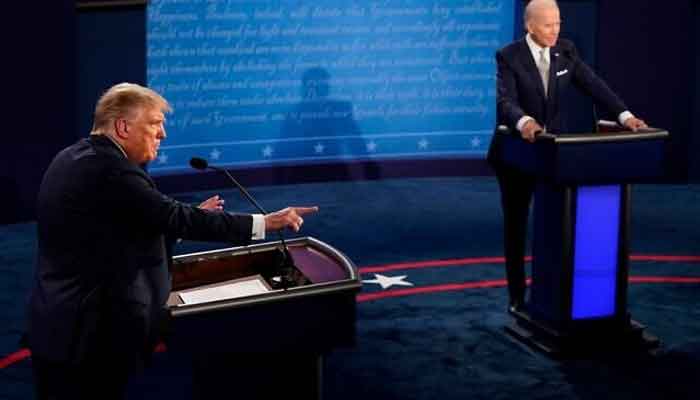Developments to watch out for during US election 2020 night and beyond
US Election 2020: Here are some moments to look for on Tuesday and beyond
November 03, 2020

The US election 2020 is upon us and many are wondering what are the key moments or announcements to watch out for, as America heads to the polls to either elect US President Donald Trump for another term or his Democrat rival Joe Biden.
The latest opinion polls show the race is close enough in the battleground states to swing the outcome to either party, even as Biden leads Trump in national polls.
Some of these states do not begin to count early votes until after polling stations close, and some allow ballots that arrive after Election Day to be included as long as they are postmarked by Nov. 3. If the presidential race depends on the outcomes in these states, America could be waiting for days.
Experts have cautioned against reading too much into early returns, which could be distorted by how each state processes the votes not cast in-person on Election Day.
Here are some moments to look for on Tuesday and beyond:
NOV 3
5 p.m. ET (2200 GMT) - Edison Research will release preliminary findings from its exit polls, which are based on in-person interviews with voters on Election Day, in-person interviews at early voting centers before Nov. 3, and telephone interviews with people who voted by mail.
The initial data will look at national and state voter sentiment and motivations, but not detailed percentage estimates. Results from ballot questions in individual states will be released after voting ends in the state.
Edison will refine and update its national and state exit poll results through the night, gathering more voter responses and adjusting the weightings to reflect turnout.
6 p.m. ET (2300 GMT) - Some polling stations begin to close in the Republican strongholds of Indiana and Kentucky, the first in the country to close.
7 p.m. ET (0000 GMT) - Voting ends in Georgia, Indiana, Kentucky, South Carolina, Virginia and Vermont.
Some polling stations begin to close in Florida, but many remain open until 8 p.m.
The initial results from Florida could favor Biden due to the high volume of early ballots that the state began to scan more than three weeks ago; opinion polls suggest more Democrats voted early, whereas more Republicans waited until Election Day. If there is a “blue mirage,” it will fade as more in-person ballots from Tuesday are tallied.
7.30 p.m. ET (0030 GMT) - Polls close in North Carolina, Ohio and West Virginia.
Like Florida, the initial results from North Carolina and Ohio could favor Biden because the states began to scan early ballots weeks before Election Day. A truer picture of the vote will emerge as more ballots are tabulated.
North Carolina counts ballots that arrive as late as Nov. 12 if they are postmarked by Nov. 3. Ohio accepts ballots 10 days after the election if they are postmarked by Nov. 2.
8 p.m. ET (0100 GMT) - Voting ends in Alabama, Connecticut, Delaware, Florida, Illinois, Maine, Maryland, Massachusetts, Mississippi, Missouri, New Hampshire, New Jersey, Oklahoma, Pennsylvania, Rhode Island, Tennessee and Washington D.C.
Pennsylvania does not begin to process early votes until Election Day and the state will accept mail-in ballots up to three days after the election if they are postmarked by Nov. 3. As a result, the initial vote counts from Pennsylvania may show a “red mirage” favoring Trump until the absentee ballots are counted, experts say.
Polling stations close in Arkansas.
9 p.m. ET (0200 GMT) - Voting ends in Arizona, Colorado, Kansas, Louisiana, Michigan, Minnesota, Nebraska, New Mexico, New York, North Dakota, South Dakota, Texas, Wisconsin and Wyoming.
Like Pennsylvania, the early results from Michigan and Wisconsin are expected to favor Trump because ballots cannot be counted before Election Day. (Michigan does allow some ballots to be opened, but they cannot be counted.)
Arizona allows ballots to be scanned 14 days before the election.
10 p.m. ET (0300 GMT) - Polls close in Iowa, Montana, Nevada and Utah.
Iowa allows ballot envelopes to be opened on the Saturday before the election and tabulating to begin on Monday. Ballots postmarked by Nov. 2 can arrive as late as the Monday after the election.
Nevada allows ballot scanning to begin 14 days before the election, and accepts ballots up to seven days after the election if they are postmarked by Nov. 3.
11 p.m. ET (0400 GMT) - Voting ends in California, Idaho, Oregon and Washington.
12 a.m. ET (0500 GMT) - Polls close in Hawaii.
1 a.m. ET (0600 GMT) - Voting ends in Alaska.
DEC 8
States have until this date, known as the “safe harbor” deadline under federal law, to resolve any disputes over their vote totals and certify the winner. If a state fails to finalize its vote count by then, Congress is no longer required to accept its results under the Electoral College system.
DEC 14
Members of the Electoral College cast their ballots for president. The candidate who receives a majority of the 538 electoral votes available, or 270, wins the presidency.
In all but two states, the winner of the state’s popular vote earns all its electoral votes, which are apportioned by population. In Maine and Nebraska, the statewide popular vote winner is awarded two electoral votes, and the remaining electoral votes are allocated to the popular vote winner in each of the state’s congressional districts.
JAN 6, 2021
Congress meets at 1 p.m. ET (1800 GMT) in Washington to count the electoral votes and declare a winner.
JAN 20, 2021
Inauguration Day. The winner and his running mate are sworn in as president and vice president at the U.S. Capitol in Washington.











